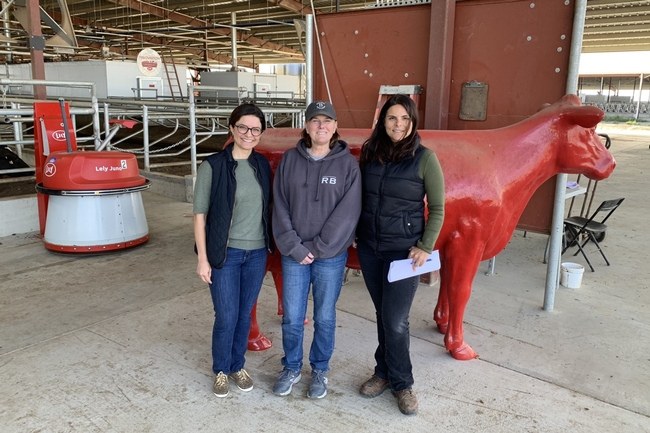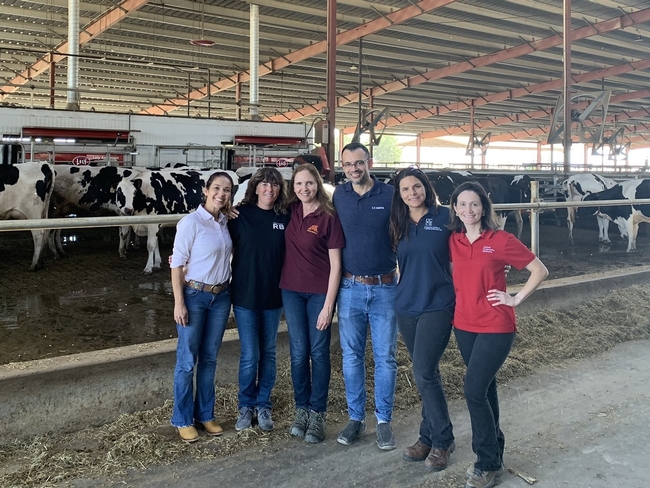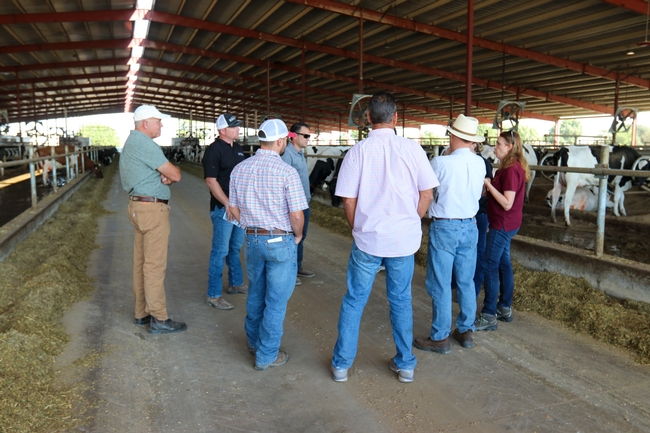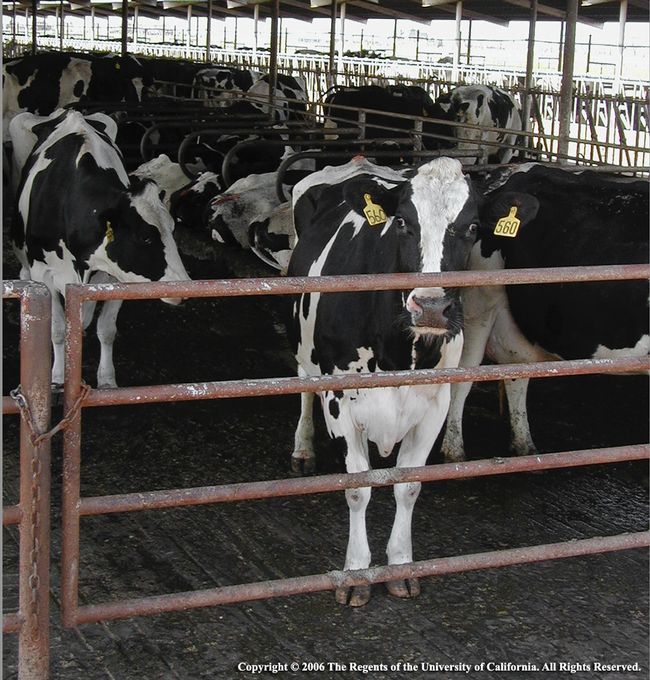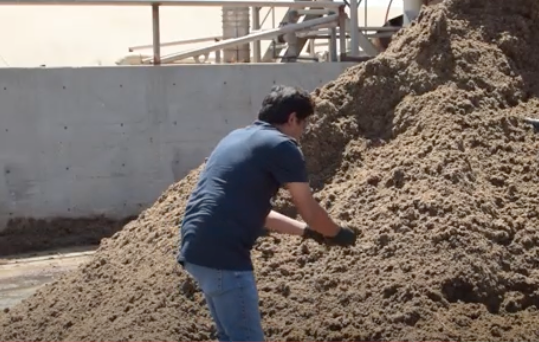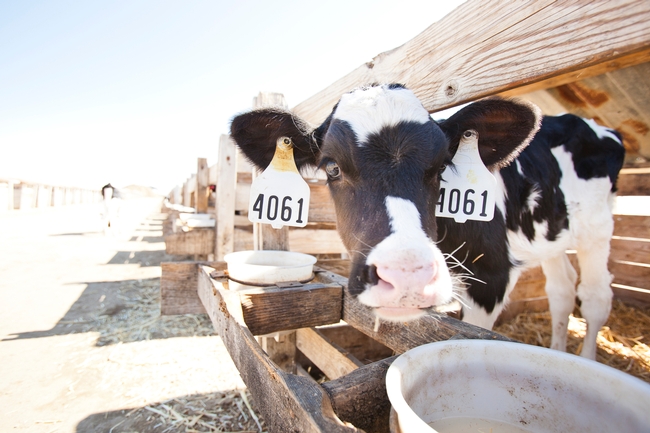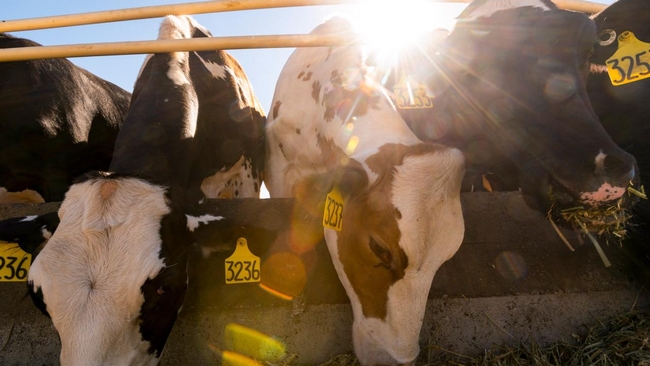Posts Tagged: cows
UCCE advisor Bruno guides, learns from dairies switching to milking robots
Automatic milking systems increasingly used in California amid labor challenges
When third-generation dairy farmer Shonda Reid first saw a milking robot at a farm show 13 years ago, she immediately recognized that the technology represented the future. Her father, however, took a bit more convincing.
“I came home and showed him and said, ‘This is what we need to do.' And he thought I was kidding!” said Reid, dairy and farm manager for Fred Rau Dairy, which has a herd of 1,400 milk cows in Fresno County.
Years later, after the family had visited several dairies using automatic milking systems (AMS) across the U.S., they installed their first six robots in November 2021. By fall 2022, they had 24 robots, evenly split between two newly built “free stall” barns where the cows can freely go to the milking machines.
As Fred Rau Dairy was one of the first in California to implement AMS at such a scale, Reid and her team have been instrumental in growing practical knowledge on these systems. She also has been a valued partner to Daniela Bruno, University of California Cooperative Extension dairy advisor for Fresno, Madera and Kings counties.
“Automatic milking robots are not a new technology, but it's new to California,” said Bruno, noting that the milking robots were first used on small, family-run farms in Europe, where the technology granted family members more time for rest and other pursuits.
To better understand the feasibility of milking robots for large dairies in California, Bruno – alongside former UC Davis School of Veterinary Medicine professor Fernanda Ferreira, University of Minnesota researcher Marcia Endres and other collaborators – began a project in 2020 to study the risks and opportunities of automated systems.
“The information is extremely useful for California producers to make informed decisions about implementing AMS on their facilities,” said Denise Mullinax, executive director of the California Dairy Research Foundation, which supported the effort through a competitive grant. “Cow care, labor requirements and profitability are key issues for producers, and CDRF was pleased to support this project which assists producers in understanding how AMS may impact those areas on their facility.”
Dairy farmer: ‘We needed to make some changes'
The project produced a paper analyzing existing research on automatic systems, which have been more widely used in the Midwest, where there are more small-scale, family-run dairies. In 2020, there were only 14 “box robots” in California, according to Bruno. Now there are about 200 across California – and both Bruno and Reid cited labor challenges as the primary reason for the increased use of automated systems.
“California suffers from labor quality and quantity issues,” Bruno said. “By bringing robots to California, you can minimize those problems.”
Higher costs of hiring and retaining employees, driven in part by new labor laws, are one factor. And then there's the reliability and availability of labor, as fewer people are willing to do the physically demanding work of conventional milking.
“People just don't want to milk in a flat barn [a conventional setup where the employee works at the same level as the cow] – there's a lot of kneeling, squatting, that type of thing – it's pretty tough on the body,” Reid explained.
Faced with labor shortages and mounting regulatory burdens, Reid said Fred Rau Dairy had to make the leap to automated systems to keep the 80-year-old dairy operation running.
“We needed to make some changes, or we're going out of the dairy business,” she said.
In a survey conducted by Bruno and her colleagues of large dairies using AMS across the U.S., a majority of the 29 respondents reported reductions in labor costs – but survey results did not offer a definitive picture on whether AMS improved bottom-line profitability.
Calmer, healthier cows
Nevertheless, most of the survey respondents said they were generally happy with their transition to automatic systems.
“It's totally met our expectations, and cow health has gotten much better, too,” Reid said.
In a typical conventional system where cows are outside in “open corral” pens, dairy employees must cajole the cows into the milking parlor. But within a “free stall” barn where the cows can voluntarily go to the milking robots when they want, as often as they want, the animals are much less stressed.
“When you think about cow handling, if you have robots, you don't have anybody pushing and screaming at them to walk to the parlor,” Bruno explained. “You have less cow-people interaction so they are more calm; there is less stress.”
In the survey of large dairies using milking robots, more than 90% of the respondents said their cows were calmer. Reid also noted that many people have noticed how calm their cows are in the free stall barns.
“They're not skittish, you can walk in and they don't run,” Reid said. “They'll just watch you or they'll even come up and start licking on your jacket or shirt.”
Bruno also said that many of the large dairies reported fewer cases of mastitis and other diseases, less lameness, and greater milk production. But she added it's hard to know whether the benefits can be attributed to the robots and their real-time monitoring technology – or to changes in the physical environment (cows save energy in the free stall barn setup, versus the open-corral system that requires walking to the milking parlor).
Dairy producers seek counsel on potential transition
Less bovine travel from outside to inside was a boon for Fred Rau Dairy during last year's unusually wet winter.
“Even if it's just a couple of weeks of rain, that mud and manure and everything – you do what you can, but oh my gosh – it's a mess,” said Reid, noting that easier facility maintenance during extreme weather was another benefit of switching to automatic systems within free stall barns.
Reid shared many of her experiences with attendees of an AMS Field Day in October 2022, arranged by Bruno, Ferreira and their collaborators. About 60 farmers, researchers, industry representatives and consultants visited Fred Rau Dairy and Jones Dairy in Merced County.
If a dairy producer is considering implementing automatic systems, Reid recommends that they research all their options, visit dairies that use the systems, and check who in their area would be providing service and technical support.
And there are crucial workforce considerations, as dairy workers must learn an entirely new set of skills and processes. Instead of spending their time fetching the cows, prepping them and milking them in the parlor, workers might need to gather and interpret data from the robots. “Cow people,” as Reid puts it, must become computer people.
“You have a group of people who have been with you for a while, and you hope that they can transition to the new technology of what you're doing,” Reid said.
During this technological transition, and on the myriad other challenges that dairy operators face, Reid said she is grateful for Bruno's expertise and responsiveness.
“If there's something that I need, she's been really good about trying to help – or putting me in contact with the right people,” she explained. “I've enjoyed working with her.”
The AMS project team also includes UC Davis School of Veterinary Medicine professor Fabio Lima, postdoctoral researcher Thaisa Marques and former postdoctoral researcher Camila Lage.
California dairy farmers generate renewable energy from waste
California ranks number one in the nation for dairy production, with 1,100 to 1,200 dairy farms, each with an average of 1,436 cows, mostly concentrated in Tulare County in the San Joaquin Valley. A major dairy waste is cow manure, a byproduct that can require millions of dollars for each dairy to manage.
To help manage the manure, the California Department of Food and Agriculture provides funds to California dairy farms to install dairy digesters, a technology that can break down manure and produce methane (a form of renewable energy). The digesters provide additional benefits such as capturing greenhouse gases while improving the nutrient value of manure and water quality.
Pramod Pandey, UC Cooperative Extension specialist in the School of Veterinary Medicine Extension at UC Davis, has been studying dairy digesters for over 20 years to understand the conversion of manure into renewable energy. He also is trying to determine the effects of anaerobic processes (in low-oxygen conditions) on dairy manure quality, biogas production and the environment.
Between 2015 and 2022, CDFA supported approximately 133 dairy digester projects in California, with grants of more than $200 million to various dairy farms.
“The California state government plays a big role in the success of this technology because the majority of dairy farmers are not financially able to invest in implementing the manure management technology, which assist both dairy farms and community,” said Pandey.
For dietary components that cannot be completely digested by a cow's stomach, dairy digesters use a variety of bacteria to break down the manure under anaerobic conditions. This provides an option for sustainable waste treatment. The process not only reduces greenhouse gas emissions by capturing the gases released from manure, but also produces renewable energy in the form of biogas, which can be used as an alternative fuel for cars to further bring down greenhouse gas emissions. In addition, the dairy digester helps reduce odor and pathogens that pose a risk to human health.
According to Pandey, one cow can theoretically produce roughly 100 pounds of wet manure daily, and this manure contains nitrogen and phosphorous, which are important for soil. About 40 cubic feet of biogas is produced from the manure of one cow under anaerobic conditions, and this biogas has a potential to produce around 24,000 btu per cow. In California, a 1,000-square foot home uses 45,000 to 55.000 btu per day for heating and cooling. That means manure from two or three cows could meet the daily energy demand of a small home.
By using digesters, farmers can prevent greenhouse gas emissions and simultaneously generate energy and soil amendments, which provide nutrients to cropland, lessening the amount of commercial fertilizer needed. By connecting technologies, the liquid from digesters can be improved to produce water that can be used for irrigation and for meeting the water demands of a dairy farm.
“The main purpose of a dairy farm is to produce milk, and current low milk prices make it difficult for dairy farmers to focus on manure management without the support from government,” Pandey said, adding that managing waste is not only expensive but time-consuming. Although dairy digesters can cost $5 million to $10 million to build and install, the technology is helpful in manure management.
Dairy farmers traditionally use anaerobic or manure lagoons to store their liquid manure waste until they are ready to apply it to farmland as fertilizer. The issue is that the lagoons emit greenhouse gases such as methane into the atmosphere.
“It is important to not overexpect from a dairy digester because it doesn't reduce all forms of pollution from manure completely,” Pandey said. “But given the available resources, funding and technology, I would say that we're off to a good start.”
Dennis Da Silva, a dairy farmer in Escalon, has been working in the industry his entire life and used to be “totally against” digesters. In the late 1970s, Da Silva's father, who immigrated from Portugal, started Da Silva Dairy Farm, which Da Silva currently runs.
“I spend a lot of money getting solids out of my lagoons every year,” Da Silva said.
Although he does not have digesters set up on his farm just yet, Da Silva agreed with Pandey that the government has made it much easier for farmers like himself to tackle waste.
“I used to be against the dairy digester idea, but there's a lot more incentive to invest these days,” said Da Silva. “It's also likely that, in the future, there'll be regulations that will crack down on dairy farms if you don't already have digesters,” he added.
Currently, he is in the permitting phase, waiting for approval to begin building the digester on his farm, which is expected to take about two years.
Pandey said that the process is slow and there is still a lot of room for improvement, but the intention is a step in the right direction. “The only thing that the digester doesn't produce is milk,” Pandey said jokingly.
RELATED LINK
VetMed Extension Spotlight on Pramod Pandey https://youtu.be/qKcGMcT8-UI.
Report: California on path to significant dairy methane reduction
Researchers say dairy farms on track to achieve full 40% reduction goal by 2030
The California Dairy Research Foundation and University of California, Davis CLEAR Center announced on Dec. 14 the release of a new analysis of methane reduction progress titled "Meeting the Call: How California is Pioneering a Pathway to Significant Dairy Sector Methane Reduction." The paper, authored by researchers at UC Davis affiliated with UC Agriculture and Natural Resources, concludes that efforts are on track to achieve the state's world-leading target for reducing dairy methane emissions by 40% by 2030.
The report, written by distinguished professors of livestock emissions and agricultural economics, takes a comprehensive look at progress and projections, expanding upon the analysis of progress previously conducted by the California Air Resources Board. By documenting achievements to date, additional reduction efforts already funded, historic and current economic trends, and the projected availability of new solutions, the analysis lays out a workable path toward meeting California's goal. The pathway shows that California dairy farms are on track to achieve the full 40% dairy methane reduction goal and will reach “climate neutrality” by 2030. Climate neutrality is the point in which no additional warming is added to the atmosphere.
“This analysis shows that California's dairy sector is well on its way to achieving the target that was established by SB 1383 in 2016,” said CDRF's Executive Director Denise Mullinax. “With much important work still ahead, a clear understanding of this pathway helps dairy farmers, policy makers, researchers, and other partners make decisions to strategically press forward.”
The report outlines the need for continued implementation of California's four-part strategy for dairy methane reduction: farm efficiency and herd attrition, methane avoidance (alternative manure management), methane capture and utilization (digesters), and enteric methane reduction. Continued alignment of state and federal climate-smart agricultural approaches and incentives will also be critical to maintaining progress.
"Milk demand is growing, and California is among the world's low-cost suppliers of dairy products. It follows that effective California policy to reduce dairy greenhouse gas emissions must recognize that measures that cause milk production to exit the state do not mitigate global climate change," said study co-author Daniel Sumner, Distinguished Professor in the Department of Agriculture and Resource Economics at UC Davis. "Therefore, measures to help off-set mitigation costs, provide positive incentives for adoption of low-cost emission-reducing practices, and help stimulate innovation in methane reduction, are the economically efficient approaches."
The paper recognizes that enteric methane from the dairy and other livestock sectors is a significant source of greenhouse gas emissions in the U.S. and California. Several feed additives are expected to become commercially available in the next several years, which could be used to reduce enteric methane emissions from California's dairy herd.
“Adoption of enteric feed additives will become a valuable tool for dairy value chains to meet their greenhouse gas reduction goals,” said co-author and professor Ermias Kebreab, associate dean of global engagement and director of the World Food Center at UC Davis. “While this report provides only a broad overview of some of the most promising solutions, there is an incredible amount of research being conducted at UC Davis, nationally and internationally. The dairy industry, global food companies, state and federal agencies, and others continue to invest heavily in supporting enteric mitigation research efforts.”
The report finds that methane reductions from California's programs and projects in place today, coupled with the implementation of a moderate feed additive strategy to reduce enteric emissions, is on track to reduce between 7.61 to 10.59 million metric tons of methane (CO2e) by 2030, all from the dairy sector alone.
The collective investment in California's dairy methane reduction effort — from public and private funding — now exceeds $2 billion and counting. The California dairy sector, in coordination with the California Department of Food and Agriculture, was recently awarded up to $85 million by the United States Department of Agriculture under the Partnerships for Climate-Smart Commodities. The funding will leverage additional matching state funds and private capital investments, for a total of more than $300 million in new investment.
“It is important to highlight California's investments and success to date as an example of what is possible within the global livestock sector,” said co-author Frank Mitloehner, UC Davis animal science professor and air quality specialist in Cooperative Extension, and director of the UC Davis CLEAR Center. “California dairy farmers have demonstrated tremendous progress toward the state's methane reduction goal over the past several years. Given the short-lived nature of methane, this rapid reduction is an important contribution to the global effort to quickly limit climate warming.”
The author's analysis was prepared by Gladstein Neandross & Associates (GNA). Funding was provided by CDRF as part of its work to support an innovative and sustainable California dairy industry.
Does social media reveal how we feel about cattle grazing?
To get a more complete picture of public perceptions of cattle grazing, Sheila Barry, University of California Cooperative Extension advisor in the San Francisco Bay Area, analyzed photos and comments in the photo-sharing website Flickr.
Her study, published in the February 2014 issue of Environmental Management, showed that Flickr can provide insight both through photos and comments into public perspectives on grazing in parks and open space lands.
“These are just a first step toward broadening this understanding,” Barry wrote. “Further analysis of social media may provide managers with broader insights into public opinion compared to those afforded by traditional methods on a wide range of issues important to park and open space management.” Livestock grazing reduces the volume of plants that can fuel fire and improves wildlife habitat. But some public land managers, concerned about potential conflicts with park users, limit or ban grazing. In 2009, the city of Walnut Creek decided to end grazing in two city parks. A year later, neighbors who were concerned about weeds contributing to wildfire petitioned the city to resume cattle grazing.
Assessments of public perceptions are often based on public hearings, which tend to attract special interests and favor negative input, or on surveys, which focus on a topic.
“Despite numerous studies that have shown benefits of grazing for endangered species in California, some environmental groups and park users have filed lawsuits to curtail grazing on public rangelands,” Barry said. “I think there's an opportunity to educate people that if grazing is well managed, it won't interfere with their recreational use and there are benefits to society.”
The San Francisco Bay Area has over 133,000 acres of public land that is grazed by cattle and used by people to hike, ride bikes, walk dogs, ride horses and hang glide.
Barry set out to explore how people voluntarily described their feelings about cattle grazing in the San Francisco Bay Area on social media. She examined photos and comments on Flickr. Using the search terms “cow,” “cows” and “grazing,” she found 1,087 photos of grazed regional parks in Alameda, Contra Costa or Santa Clara counties by 328 people with 956 comments.
Of the 733 photos that were accompanied by comments, 71 percent showed a cow and 71 percent of the comments were descriptive without expressing opinion about cows or grazing. Comments included “Lots of wildflowers and cows. Hello tiny cows on the hillside.” “Taken at Lake Del Valle.” “I don't know why, but I thought cows in California were kept indoors.” About 23 percent were positive toward cows and grazing, such as “Wonderful to see cows being just cows and happy ones” and “As much as I struggled over the steep hills on this hike, all the grazing cattle and howling coyotes made it worth the sweat.”
Fear of cows was expressed by 5 percent of commenters and included comments such as “I try to conquer my fear of cows by photographing them,” “The cows scared us to death. I told them that I'm a vegetarian and they let me go” and “We turned around when we were faced with the option of having to walk right through a herd of cows.”
Less than 1 percent described cows behaving aggressively, such as “At least these cows didn't chase us like last week's did.”
Although more research is needed to learn how to collect, analyze and interpret data from social media, Barry believes it could be a valuable source for informing decisions about public policy.
Insight into public perceptions of cattle grazing will enable park managers to craft more effective education and interpretation messages about park use and management.
“We are currently using insight from this project to develop education and interpretative information and panels for parks in the East Bay,” Barry said.
Barry is publishing fact sheets for park managers and interpreters to share with park visitors. The fact sheets will address concerns she saw raised in the Flickr study such as how to safely and comfortably recreate in a park near grazing cattle and the benefits of cattle grazing in parks. She will also address public interest and questions revealed in the Flickr study with facts sheets titled “A Year in the Life” and “Bovines, Ovines, Caprines and Equines: What's the difference?” The fact sheets will also be available online and similar information will be posted in parks on interpretative panels.
The article “Using Social Media to Discover Public Values, Interests, and Perceptions about Cattle Grazing on Park Lands” can be downloaded at http://link.springer.com/article/10.1007%2Fs00267-013-0216-4.

